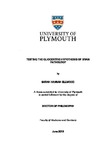Testing the Gliocentric Hypothesis of Brain Pathology
| dc.contributor.supervisor | Fern, Robert | |
| dc.contributor.author | Ellwood, Sarah Hannah | |
| dc.contributor.other | Faculty of Health | en_US |
| dc.date.accessioned | 2019-07-31T09:22:10Z | |
| dc.date.available | 2019-07-31T09:22:10Z | |
| dc.date.issued | 2019 | |
| dc.identifier | 10527741 | en_US |
| dc.identifier.uri | http://hdl.handle.net/10026.1/14722 | |
| dc.description.abstract |
Ischaemic stroke is a leading cause of death and disability worldwide, causing cell death and tissue damage. All cell types are affected by ischaemia, however until recently, the impact of acute ischaemia has been studied from a neuronal point of view. Currently, there is a greater interest in glial cells such as astrocytes and oligodendrocytes as they are essential for the correct working of the central nervous system (CNS). This thesis aimed to investigate the regional sensitivity of the glial cells and the mechanisms behind any regional differences. Three mechanistic areas were chosen to be examined; the role of glycogen stores, cytotoxic ion influx through glutamate receptors and the involvement of sodium and cell swelling. Investigation into glial sensitivity was carried out via live imaging of brain slice and optic nerve preparations from transgenic mice which specifically expressed GFP in either astrocytes or oligodendrocytes. Ischaemia was modelled using oxygen glucose deprivation (OGD). It was determined that astrocytes display regional differences in sensitivity to ischaemic insult. The most sensitive region was the dentate gyrus (DG), and corpus callosum (CC) was the least sensitive. Mature oligodendrocyte somas were found to be tolerant to acute ischaemia. Mechanistic investigation revealed that the presence and access to glycogen prevented and attenuated OGD induced cell death in CC. It was found that astrocyte injury may be mediated by AMPA receptors. OGD induced astrocyte cell death was found to be sodium dependent in DG but not in CC. The findings strongly indicate that astrocyte regional sensitivity to ischaemia exists and that there are different OGD induced cell death mechanisms depending upon the physical location of the astrocyte population. This provides further information about the effect of ischaemia on glial cells and provides targets to be further investigated to assist with the recovery of tissue after ischaemic insult. | en_US |
| dc.language.iso | en | |
| dc.publisher | University of Plymouth | |
| dc.rights | Attribution 3.0 United States | * |
| dc.rights.uri | http://creativecommons.org/licenses/by/3.0/us/ | * |
| dc.subject | Astrocytes | en_US |
| dc.subject | Ischaemia | en_US |
| dc.subject | Glia | en_US |
| dc.subject | Glycogen | en_US |
| dc.subject | Cytotoxic ion influx | en_US |
| dc.subject | Astrocyte sensitivity | en_US |
| dc.subject.classification | PhD | en_US |
| dc.title | Testing the Gliocentric Hypothesis of Brain Pathology | en_US |
| dc.type | Thesis | |
| plymouth.version | publishable | en_US |
| dc.identifier.doi | http://dx.doi.org/10.24382/1169 | |
| dc.rights.embargoperiod | No embargo | en_US |
| dc.type.qualification | Doctorate | en_US |
| rioxxterms.funder | Plymouth University | en_US |
| rioxxterms.identifier.project | Testing the Gliocentric Hypothesis of Brain Pathology | en_US |
| rioxxterms.version | NA | |
| plymouth.orcid_id | 0000-0002-9821-4167 | en_US |
Files in this item
This item appears in the following Collection(s)
-
01 Research Theses Main Collection
Research Theses Main



